
SOMA Review
A monster-breeding underwater city sounds like a trope a bit too familiar to all first-person enthusiasts. Nevertheless, whereas Rapture’s story was imbued with political denotations, SOMA’s Pathos-II begs questions about what’s a life worth living and what makes us humans. It frames them in a gloomy and grievous context, where our answers are somehow determined. Pathos-II starts off as a geothermal power plant, but ends up being the last human inhabited shelter in the world. And shortly after, we — Simon — turn up in this H.R. Giger-esque nightmare, not knowing how or why.
This premise goes beyond the overly-typical protagonist’s ‘blank slate’, but rather is used as a tool to explore these questions about our own human nature; pushing them to the confines of Philip K. Dick’s human/robot dichotomy. As much as this theme follows the main character’s story throughout, it is inevitable to find some aspects simplistic and predictable — such as the very ending segment, which is thoroughly foreshadowed. It evokes unsettledness by using solitude and our individual humanity as a pivot point, and it contrasts it the end goal of the game, which in turn, is socially prosperous.
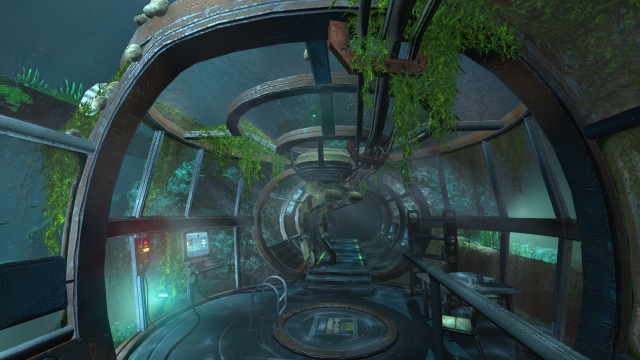 Is life worth living? Well, life’s not as inviting if we share a bed with a murdering monster portending our demise. If SOMA had framed these questions within a more social and optimistic tone, rather than our own individuality, maybe the answers would have elicited much more personal responses, prompting us to consider the pros and cons of what SOMA brings to the table. The Last of Us’s ending would have not brought about as many tears without the galvanising endearment towards Ellie. This setting, however, is cleverly used to narrow and sculpt your thoughts on your duty within Pathos-II.
Is life worth living? Well, life’s not as inviting if we share a bed with a murdering monster portending our demise. If SOMA had framed these questions within a more social and optimistic tone, rather than our own individuality, maybe the answers would have elicited much more personal responses, prompting us to consider the pros and cons of what SOMA brings to the table. The Last of Us’s ending would have not brought about as many tears without the galvanising endearment towards Ellie. This setting, however, is cleverly used to narrow and sculpt your thoughts on your duty within Pathos-II.
But in Pathos-II, we’re alone, for the most part. We have lost everything that was dear to us, and in spite of it, we venture into the depths with nothing but our poor ability to circumvent monsters. The comparison with Amnesia: The Dark Descent is unavoidable, and perhaps something that doesn't necessarily leave SOMA in a better position. Amnesia uses horror to evoke that lingering paranoia, reaching to primal triggers, leaving us fearing what’s around every corner. Conversely, SOMA focuses on asking questions that are deeply personal and barely answerable, transforming its creatures and its horror as a mean to do so.
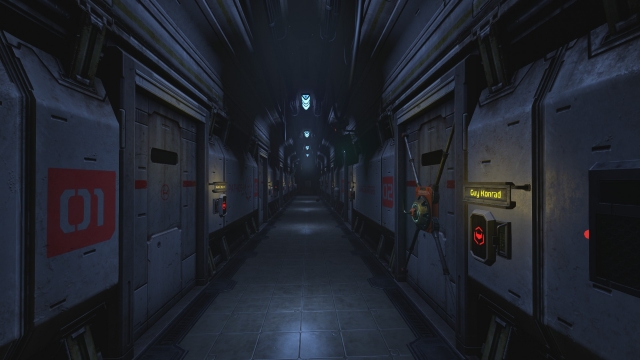 However, the enemy and level design is odd and lacklustre. Corridor loops and dark and labyrinthine rooms forewarn about enemy presence, which is itself made obvious by the fact that when we look in their direction, they are alerted, our life depletes and our vision gets distorted. Some sounds, like our footsteps, alert them of our presence, but tripping over an oil can and kicking it halfway across the room doesn't. What at first seemed like a teleporting pattern resulted in a glitchy spawn system, and their spotting range is unclear and independent of lighting.
However, the enemy and level design is odd and lacklustre. Corridor loops and dark and labyrinthine rooms forewarn about enemy presence, which is itself made obvious by the fact that when we look in their direction, they are alerted, our life depletes and our vision gets distorted. Some sounds, like our footsteps, alert them of our presence, but tripping over an oil can and kicking it halfway across the room doesn't. What at first seemed like a teleporting pattern resulted in a glitchy spawn system, and their spotting range is unclear and independent of lighting.
There isn’t the gradual and methodical progression anymore, as there used to be in Amnesia. Level design forces us to either brute-force our way to the end, by trying to outrun the enemy while withstanding its attacks; or curling up in a corner of the room, as there is almost no place to hide in the whole of Pathos-II’s facility. Being in plain sight, staring at the wall while the enemy roams around, results in a very absurd and frustrating mechanic, as at that point there’s very little we can do to avoid being detected. These awkward situations are laughable and when they happen — very often, I should say —, they break the tension bubble making enemies so fearsome.
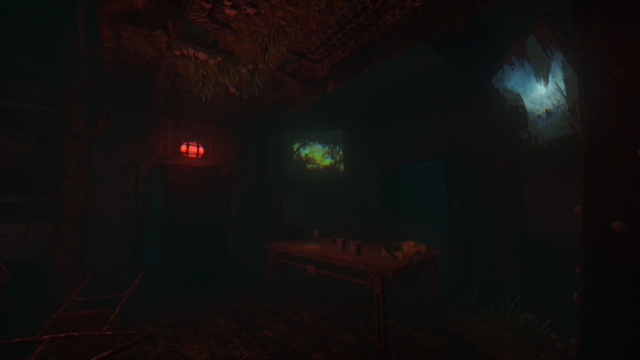 Pathos-II is full of details and objects that tell stories and we can interact with. It may not be the best setting to hide around and avoid hellish creatures, but it provides a rich atmosphere, being as cold and perturbing as it is realistic and enthralling. Even though the level design gives enemies and objectives away, it also contrasts the danger areas with the safe ones, making every safe haven comforting and rewarding, as we learn about the facility through the conversations with Catherine, our sporadic companion throughout the game. These talks between Simon and Catherine are what drives Simon into the ocean abyss and where most of the emotional weight is placed.
Pathos-II is full of details and objects that tell stories and we can interact with. It may not be the best setting to hide around and avoid hellish creatures, but it provides a rich atmosphere, being as cold and perturbing as it is realistic and enthralling. Even though the level design gives enemies and objectives away, it also contrasts the danger areas with the safe ones, making every safe haven comforting and rewarding, as we learn about the facility through the conversations with Catherine, our sporadic companion throughout the game. These talks between Simon and Catherine are what drives Simon into the ocean abyss and where most of the emotional weight is placed.
The recordings and emails found in computers — with an oddly basic and curbed interface — also convey the hope and angst that the crew inside Pathos-II experienced. Although not strictly necessary to understand and follow the plot, it gives great insight regarding the crew’s motivations and relations with each other, making the story profoundly humane in spite of the great array of conscience-less robots roaming around the labs.
The ambiguity of the morality included in the decisions that we make settle any pre-existing thoughts that we could have regarding the theme prevalent in the game. The dark and cruel comedic undertone touted in the first third of the game gradually vanishes to allow for a paradoxical and depressive series of events – with references to authors such as Poul Anderson —, forcing the player to deal with the consequences of brutal actions, because they were more merciful and beneficial in the long run. The game uses these events to clarify the plot and the game’s intentions, and they will haunt you well after they happen.
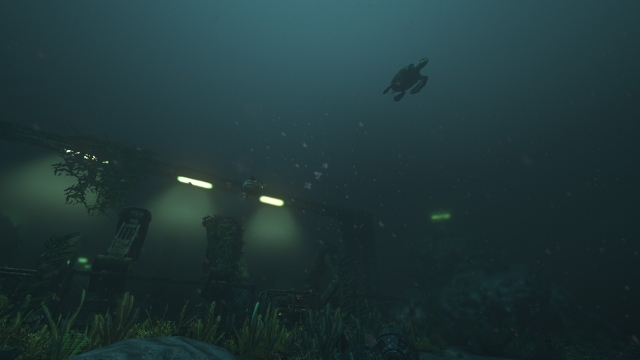 Alongside the decisions we've made, the creaking of the pipes, the overwhelming silence of the bottom of the ocean and the constant flickering of panel lights give Pathos-II an ability to immerse the player that Amnesia didn't have. The chromatic aberration that filters your vision for most of the game can be obnoxious at points, but it flows along the idea of coexistence with robots. It all converges into a visual feast of black gurgling goo covering walls, corpses and machines. The facility might be under clear takeover by this ‘structure gel’, but that doesn’t stop it from being suggestive and dazzling to look at, accompanied by a cast of evocative sound effects that spur the player to keep moving, and always be on their toes. Likewise, the emotional connection with the characters wouldn’t have been possible without such a coactive and expressive voice-over.
Alongside the decisions we've made, the creaking of the pipes, the overwhelming silence of the bottom of the ocean and the constant flickering of panel lights give Pathos-II an ability to immerse the player that Amnesia didn't have. The chromatic aberration that filters your vision for most of the game can be obnoxious at points, but it flows along the idea of coexistence with robots. It all converges into a visual feast of black gurgling goo covering walls, corpses and machines. The facility might be under clear takeover by this ‘structure gel’, but that doesn’t stop it from being suggestive and dazzling to look at, accompanied by a cast of evocative sound effects that spur the player to keep moving, and always be on their toes. Likewise, the emotional connection with the characters wouldn’t have been possible without such a coactive and expressive voice-over.
Nevertheless, SOMA’s best asset in comparison to Amnesia is its pacing. SOMA’s puzzles haven’t been made easier, but its design is generally much more enclosed within the area you’re in. It might take you a bit to figure out how to solve it, but all the clues are right in front of you. With a revisit to the approach to puzzles, the inventory-management and sanity system has been dropped. This generally makes the progression more dynamic, and helps the player focus on the story and the action. The number of objects now laying around the rooms is much larger, the environments much richer and the lighting wavers due to the different light colours. Perhaps the exclusion of item pick-ups was a result of decluttering the environment; perhaps Pathos-II’s atmosphere didn’t work with the sanity system; in any case, there is a lack of tension due to it, albeit compensated with a more story-focused and enterprising narrative.
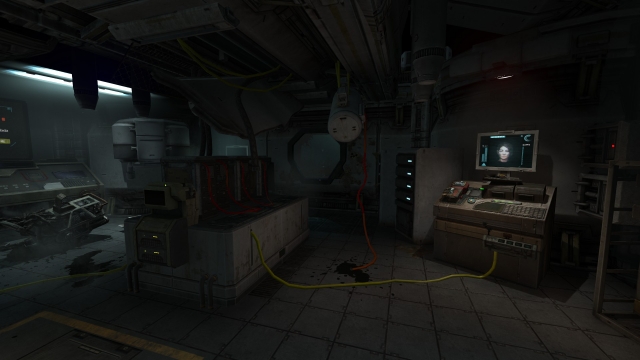 SOMA feels like a step down from Amnesia: The Dark Descent in some regards. The technical performance excels at all time, but its level design and mechanics have been slightly thwarted. Its thought-provoking well-paced plot, sound and visual design work much better, but some limitations in gameplay make it not fully live up to its legacy. The cathartic up-pace of the final segment is a clear example of how action-focused this game is in comparison, and it executes its emotional ride brilliantly, albeit of its pretentious but overly simplistic and predictable intentions. If the monsters had been half as well-designed as the overarching plot, this game would have fixed a great deal of its issues.
SOMA feels like a step down from Amnesia: The Dark Descent in some regards. The technical performance excels at all time, but its level design and mechanics have been slightly thwarted. Its thought-provoking well-paced plot, sound and visual design work much better, but some limitations in gameplay make it not fully live up to its legacy. The cathartic up-pace of the final segment is a clear example of how action-focused this game is in comparison, and it executes its emotional ride brilliantly, albeit of its pretentious but overly simplistic and predictable intentions. If the monsters had been half as well-designed as the overarching plot, this game would have fixed a great deal of its issues.
SOMA (Reviewed on Windows)
This game is great, with minimal or no negatives.
SOMA's thought-provoking well-paced plot, sound and visual design work great, but some limitations in gameplay make it not fully live up to its legacy. It is a highly recommendable game, but unlike Amnesia, it isn't going to spur to a whole genre. In fact, it is not even the best ones in the genre.












COMMENTS
The Griddler - 10:22am, 10th November 2015
I think I'm finally ready for another Frictional Games title. I'm glad they removed the inventory and sanity system for SOMA, the streamlined approach worked well in A Machine For Pigs.